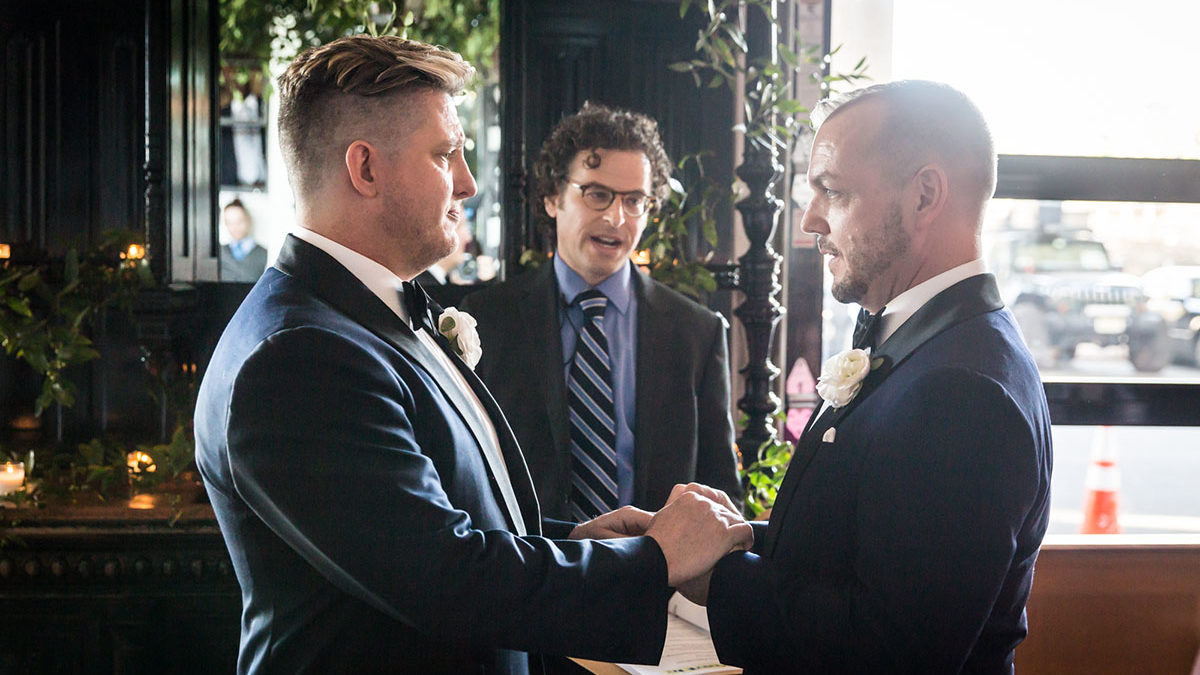LGBTQ+ friendly wedding pros, LGBTQ+ couples and our allies know that a wedding is a wedding is a wedding. No government or religious institution has the right to tell us that our weddings are not valid weddings or that gay marriage isn’t equal to straight marriage just because the law, certain segments of society or religious stance hasn’t quite caught up to the fact that marriage equality is a basic human right.
However, marriage equality is important when it comes to increased protection for our community as well as visibility and normalizing of LGBTQ+ weddings, commitment, marriage, families and basic humanity. Here’s the latest list of countries that allow gay marriage, according to Pew Research Center.
Countries That Allow Gay Marriage
Australia (2017)
On Dec. 7, 2017, the Australian Parliament passed legislation allowing gay and lesbian couples to legally wed. Passage came just three weeks after Australians voted in favor of legalizing same-sex marriage, by a 62% to 38% margin, in a non-binding, nationwide referendum. Along with New Zealand, Australia became the second country in the Asia-Pacific region to to make same-sex marriage legal.
Austria (2019)
Same-sex marriage in Austria has been legal since January 1, 2019, following a decision of the Constitutional Court on December 4, 2017. The country has allowed registered partnerships (German: Eingetragene Partnerschaft) since January 1, 2010.
Malta (2017)
Malta’s parliament almost unanimously voted to legalize same-sex marriage in July 2017, despite opposition from the Catholic Church on the small Mediterranean island.
Germany (2017)
On June 30, 2017, Germany became the 15th European country to enact legislation allowing same-sex couples to wed. The 393-226 vote in the nation’s Bundestag (or Parliament) came just days after Chancellor Angela Merkel surprised many by saying that members of her ruling Christian Democratic Union should be able to vote their conscience on the issue even though the party formally opposes same-sex marriage.
Colombia (2016)
On April 28, 2016, Colombia became the fourth country in Catholic-majority South America to legalize same-sex marriage, following Argentina, Uruguay and Brazil. The country’s Constitutional Court, by a 6-3 vote, ruled that that “all people are free to choose independently to start a family in keeping with their sexual orientation … receiving equal treatment under the constitution and the law,” according to the wire service Agence France-Presse.
United States (2015)
Eleven years after same-sex marriage was first made legal in Massachusetts, the U.S. Supreme Court ruled that the Constitution guarantees it throughout the country. The 5-4 decision rests in part on the court’s interpretation of the 14th Amendment, and states that limiting marriage only to heterosexual couples violates the amendment’s guarantee of equal protection under the law. Before the ruling, 36 states and the District of Columbia had legalized same-sex marriage. See a timeline highlighting changes in state policies from 1995-2015.
Greenland (2015)
Greenland, an autonomous territory of Denmark, was not subject to Denmark’s same-sex marriage law, which was enacted in 2012. However, legislators in Greenland passed a bill in May 2015 to legalize same-sex marriage on the world’s biggest island.
Ireland (2015)
On May 22, 2015, Catholic-majority Ireland became the first country to legalize same-sex marriage through a popular referendum. More than six-in-ten Irish voters (62%) voted “yes” to amend the Constitution of Ireland to say that “marriage may be contracted in accordance with law by two persons without distinction as to their sex.”
While some Catholic Church leaders opposed the change, Dublin Archbishop Diarmuid Martin wrote a commentary in The Irish Times newspaper before the referendum, saying that he would not tell people how to vote and that he had “no wish to stuff my religious views down other people’s throats.” Irish Prime Minister Enda Kenny supported the “yes” campaign.
Finland (2015)
Same-sex marriage will become legal in Finland starting in 2017. The Finnish Parliament approved a bill legalizing same-sex unions in November 2014, and Finland’s president, Sauli Niinistö, signed the measure into law in February 2015. The bill started out as a “citizens’ initiative” – a public petition with a reported 167,000 signatures.
Finland becomes the last of the five Nordic countries to legalize same-sex marriage, joining Denmark, Iceland, Norway and Sweden.
Luxembourg (2014)
On June 18, Luxembourg’s parliament, the Chamber of Deputies, overwhelmingly approved legislation that will allow gay and lesbian couples to wed and to adopt children. The bill, which took effect in early 2015, was championed by the country’s prime minister, Xavier Bettel, who is openly gay.
The changes are part of a larger rewrite of the tiny country’s marriage laws – the first major overhaul since 1804. In addition to allowing same-sex couples to marry and adopt, the legislation sets the legal age of marriage at 18 and eliminates the existing requirement that couples who want to marry must first submit to a medical exam.
Scotland (2014)
On Feb. 4, 2014, the Scottish Parliament voted overwhelmingly to approve legislation legalizing same-sex marriage. In addition to allowing same-sex couples to wed, the measure gives churches and other religious groups the option of deciding whether or not they want to conduct such marriages. The two largest churches in Scotland – the Church of Scotland and the Roman Catholic Church – oppose same-sex marriage and lobbied against the bill.
The law took effect and same-sex couples began marrying in Scotland in December 2014.
England and Wales (2013)
On July 17, 2013, Queen Elizabeth II gave her “royal assent” to a bill legalizing same-sex marriage in England and Wales. The day before, the measure had won final passage in the British Parliament after months of debate. The law only applies to England and Wales because Scotland and Northern Ireland are semi-autonomous and have separate legislative bodies to decide many domestic issues, including the definition of marriage. While Northern Ireland’s legislature in April 2014 voted down a measure that would have legalized same-sex marriage, the Scottish Parliament passed a bill to legalize same-sex marriage in February 2014.
The new law in England and Wales, which was a priority for British Prime Minister and Conservative Party leader David Cameron, allowed gay and lesbian couples to marry beginning March 29, 2014. However, the law prohibits same-sex weddings within the Church of England, which continues to define marriage as between one man and one woman.
Brazil (2013)
On May 14, 2013, Brazil’s National Council of Justice ruled that same-sex couples should not be denied marriage licenses, allowing same-sex marriages to begin nationwide. (Previously, about half of Brazil’s 27 jurisdictions had allowed same-sex marriage.)
The conservative Social Christian Party has appealed the Council of Justice’s decision to the Supreme Court, and Brazil’s legislature may still weigh in on the issue, leaving some uncertainty surrounding the future of same-sex marriage in the world’s fifth-largest country.
France (2013)
On May 18, French President Francois Hollande signed into law a measure legalizing same-sex marriage, making France the 14th country to grant gays and lesbians the right to wed. Although the bill had passed the National Assembly and the Senate in April, Hollande’s signature had to wait until a court challenge brought by the conservative opposition party, the UMP, was resolved. On May 17, France’s highest court, the Constitutional Council, ruled that the bill was constitutional.
In May 2012, Hollande was elected and his Socialist Party won majorities in both houses of France’s legislature. True to their campaign promises, Hollande and the Socialists have pushed through a law that not only legalizes same-sex marriage but also gives gay and lesbian couples the right to adopt children—a provision that has drawn especially strong criticism from French Catholic leaders.
While recent polls show that a majority of French adults support the law, opposition to the change has been intense. Since the beginning of 2013, several anti-gay marriage protests with occasionally volatile crowds numbering in the hundreds of thousands have taken place in Paris and elsewhere.
New Zealand (2013)
On April 17, the New Zealand Parliament gave final approval to a measure that legalizes same-sex marriage, making the Pacific island nation the 13th country in the world and the first in the Asia-Pacific region to allow gays and lesbians to wed. The measure won approval by a 77-44 margin in the country’s unicameral legislature, including support from Prime Minister John Key, and was signed by the country’s governor-general (a process known as royal assent) on April 19. The law took effect in August 2013.
In 2005, New Zealand enacted legislation allowing same-sex couples to enter into civil unions. The 2013 measure not only legalizes same-sex marriage but also allows for gay and lesbian couples to adopt children.
Uruguay (2013)
On April 10, the lower house of Uruguay’s Congress passed legislation legalizing same-sex marriage, a week after the country’s Senate did so. President José Mujica signed the bill into law on May 3, making Uruguay the second Latin American country to legalize same-sex marriage, following Argentina. Civil unions have been permitted in Uruguay since 2008, and gay and lesbian couples were given adoption rights in 2009.
Uruguay is among the most secular countries in Latin America. A Pew Research Center study on the global religious landscape as of 2010 found that roughly four-in-ten Uruguayans are unaffiliated with a particular religion. About 58 percent of Uruguayans are Christian; in the Latin America-Caribbean region as a whole, 90 percent of the population is Christian.
Denmark (2012)
In June 2012, Denmark’s legislature passed a bill legalizing gay marriage. The measure was enacted into law a few days later when Queen Margrethe II gave her royal assent to the bill.
In 1989, Denmark became the first country to allow same-sex couples to register as domestic partners. And in 2010, the country enacted a law allowing gay couples in registered partnerships the right to adopt children.
With the legalization of gay marriage, the Evangelical Lutheran Church in Denmark (which is the state church), is required to allow same-sex couples to marry in churches. However, no member of the church’s clergy is required to perform the wedding of a gay or lesbian couple. In addition, the law leaves it up to other religious groups to determine whether or not to allow same-sex weddings in its churches.
Argentina (2010)
In July 2010, Argentina became the first country in Latin America to legalize same-sex marriage. In spite of vigorous opposition from the Catholic Church and evangelical Protestant churches, the measure passed both houses of the Argentine legislature and was signed into law by President Cristina Fernandez de Kirchner. The law grants same-sex couples who marry all the rights and responsibilities enjoyed by heterosexual couples, including the right to adopt children.
In the decade before the enactment of the same-sex marriage law, a number of local jurisdictions, including the nation’s capital, Buenos Aires, had enacted laws allowing gays and lesbians to enter into civil unions.
Portugal (2010)
In June 2010, Portugal became the eighth country to legalize same-sex marriage. Its parliament had passed the measure legalizing gay marriage earlier in 2010. But following its passage, Portugal’s president, Anibal Cavaco Silva, asked the Constitutional Court to review the measure. In April 2010, the Constitutional Court declared the law to be constitutionally valid. It was signed by Silva in May of that year and took effect one month later. Portugal’s gay marriage law does not give married same-sex couples the right to adopt children.
Iceland (2010)
A measure legalizing same-sex marriage passed the Icelandic legislature in June 2010. Public opinion polls prior to the vote indicated broad support for the measure, and no members of the country’s legislature voted against it. Iceland had allowed same-sex couples to register as domestic partners since 1996. A decade later, the parliament passed a measure allowing gay couples to adopt children.
After the new law took effect in late June 2010, the country’s prime minister, Johanna Sigurdardottir, wed her longtime partner, Jonina Leosdottir, becoming one of the first people to marry under the statute.
Sweden (2009)
In April 2009, the Swedish parliament voted by an overwhelming majority to legalize same-sex marriage. Gay couples in Sweden had been allowed to register for civil unions since 1995.
The 2009 law allows gays and lesbians to marry in both religious and civil ceremonies, but it does not require clergy to officiate at such ceremonies. The Lutheran-affiliated Church of Sweden, to which roughly three-quarters of all Swedes belong, has offered blessings for same-sex partnerships since January 2007. In October 2009, the church’s governing board voted to allow its clergy to officiate at same-sex marriage ceremonies.
Norway (2008)
Since January 2009, gay couples in Norway legally have been able to marry, adopt children and undergo artificial insemination. The new law, which was passed in 2008, replaced a 1993 law permitting civil unions. It passed despite resistance from members of the Christian Democratic Party and the Progress Party, as well as a public controversy over state funding for fertility treatments for lesbian couples.
The largest religious group in the country, the Lutheran-affiliated Church of Norway, initially voted to prohibit its pastors from conducting same-sex weddings. But the Church of Norway changed course and began sanctioning same-sex weddings in early 2017.
South Africa (2006)
The South African parliament legalized same-sex marriage in November 2006, one year after the country’s highest court ruled that the previous marriage laws violated the South African constitution’s guarantee of equal rights. The new law allows for religious institutions and civil officers to refuse to conduct same-sex marriage ceremonies, a provision that critics claim violates the rights of same-sex couples under the constitution.
The new measure passed by a margin of greater than five-to-one, with support coming from both the governing African National Congress as well as the main opposition party, the Democratic Alliance. However, the traditional monarch of the Zulu people, who account for about one-fifth of the country’s population, maintains that homosexuality is morally wrong.
Spain (2005)
A closely divided Spanish parliament legalized same-sex marriage in 2005, guaranteeing identical rights to all married couples regardless of sexual orientation. The new measure added language to the existing marriage statute, which now reads, “Marriage will have the same requirements and results when the two people entering into the contract are of the same sex or of different sexes.”
Vatican officials, as well as the Catholic Spanish Bishops Conference, strongly criticized the law, and large crowds demonstrated in Madrid for and against the measure. After the law went into effect, the country’s constitutional court rejected challenges from two municipal court judges who had refused marriage licenses to same-sex couples. The high court ruled that the lower court judges lacked legal standing to bring the suits.
Canada (2005)
Same-sex couples in Canada gained most of the legal benefits of marriage in 1999 when the federal and provincial governments extended common law marriages to gay and lesbian couples. Through a series of court cases beginning in 2003, same-sex marriage gradually became legal in nine of the country’s 13 provinces and territories. In 2005, the Canadian Parliament passed legislation making same-sex marriage legal nationwide. In 2006, lawmakers defeated an effort by the ruling Conservative Party of Canada to reconsider the issue, leaving the law unchanged.
Belgium (2003)
Beginning in 1998, the Belgian parliament offered limited rights to same-sex couples through registered partnerships. Same-sex couples could register with a city clerk and formally assume joint responsibility for a household. Five years later, in January 2003, the Belgian parliament legalized same-sex marriage, giving gay and lesbian couples the same tax and inheritance rights as heterosexual couples.
Support for the law came from both the Flemish-speaking North and the French-speaking South, and the law generated surprisingly little controversy across the country. The long-dominant Christian Democratic Party, traditionally allied with the Catholic Church, was out of power when the parliament passed the measure.
The 2003 law allowed the marriages of Belgian same-sex couples and recognized as married those from other countries where same-sex marriage was legal. Those provisions were broadened in 2004 to allow any same-sex couple to marry as long as one member of the couple had lived in Belgium for at least three months. In 2006, the parliament also granted same-sex partners the right to adopt children.
The Netherlands (2000)
In December 2000, the Netherlands became the first country to legalize same-sex marriage when the Dutch parliament passed, by a three-to-one margin, a landmark bill allowing the practice. The legislation gave same-sex couples the right to marry, divorce and adopt children. The legislation altered a single sentence in the existing civil marriage statute, which now reads, “A marriage can be contracted by two people of different or the same sex.”
The only opposition in parliament came from the Christian Democratic Party, which at the time was not part of the governing coalition. After the law went into effect, the Protestant Church in the Netherlands, which then represented about 12% of the country’s population, announced that individual congregations could decide whether to conduct same-sex marriage ceremonies. Although Muslim and conservative Christian groups continue to oppose the law, same-sex marriage is widely accepted by the Dutch public.
Countries Where Gay Marriage is Legal in Some Jurisdictions
Mexico (2009)
In 2015, the Mexican Supreme Court issued a ruling making it much easier for gay and lesbian couples to wed. The decision gave same-sex couples the right to seek a court injunction against state laws banning gay marriage; although it did not technically legalize same-sex unions nationwide, it was a major step in that direction. Mexico’s Supreme Court also issued a ruling in favor of same-sex marriage in 2010, saying that same-sex marriages performed in Mexico City were valid and that they must be accepted throughout the country (Mexico City had legalized gay marriage in December 2009). Since 2011, the southern Mexican state of Quintana Roo also has allowed gay marriages. In 2014, the congress of the northern state of Coahuila approved same-sex marriage, and in 2015, neighboring Chihuahua followed suit.
Source: Pew Senior Researcher David Masci, Research Analyst Elizabeth Sciupac and Editor Michael Lipka, Wikipedia
This article was last updated September 13, 2019
Photo: Kelly Williams

































